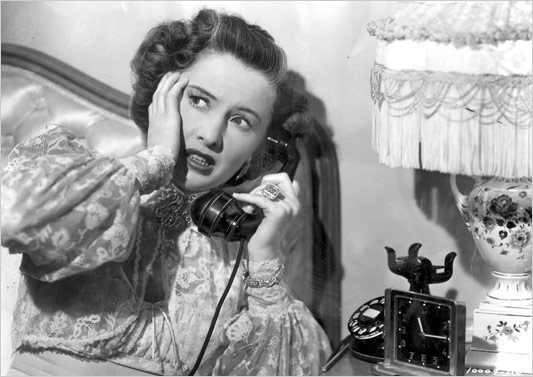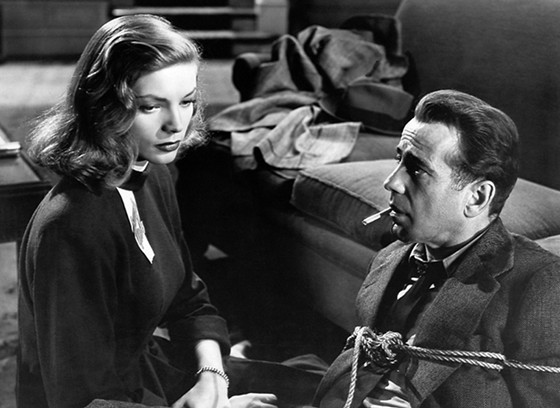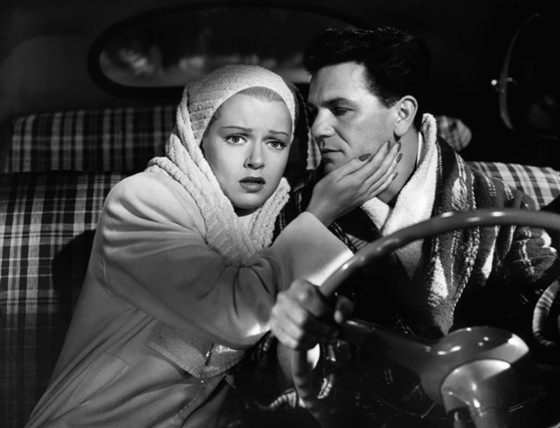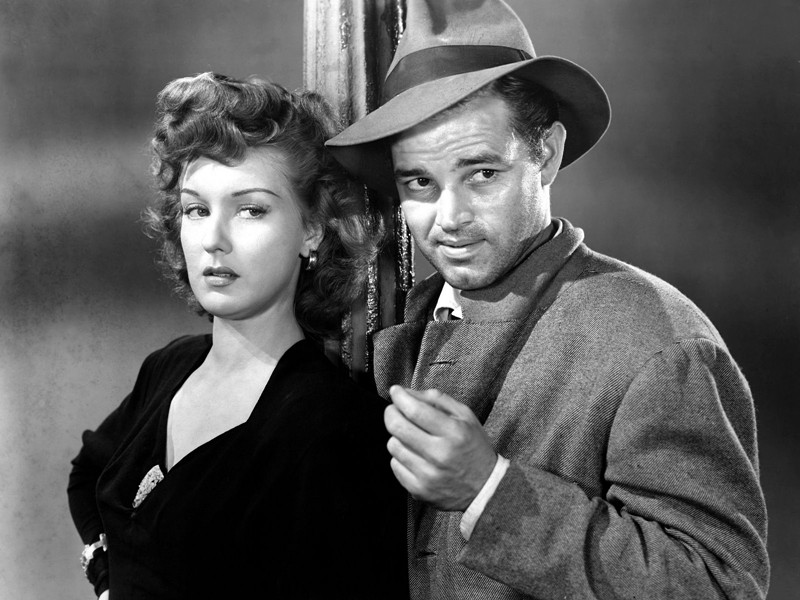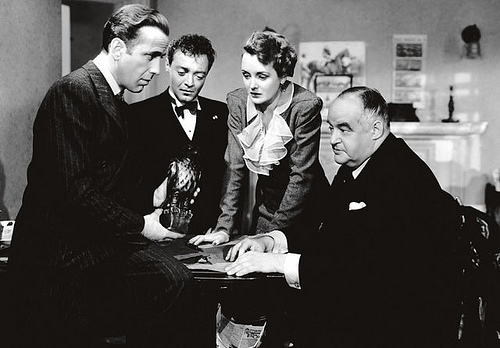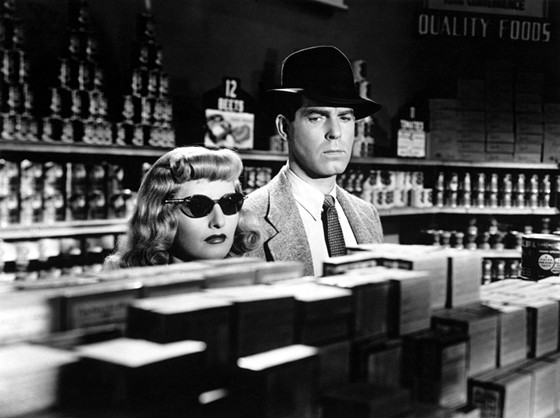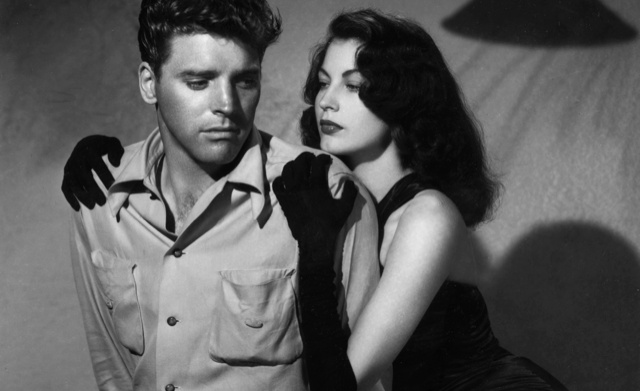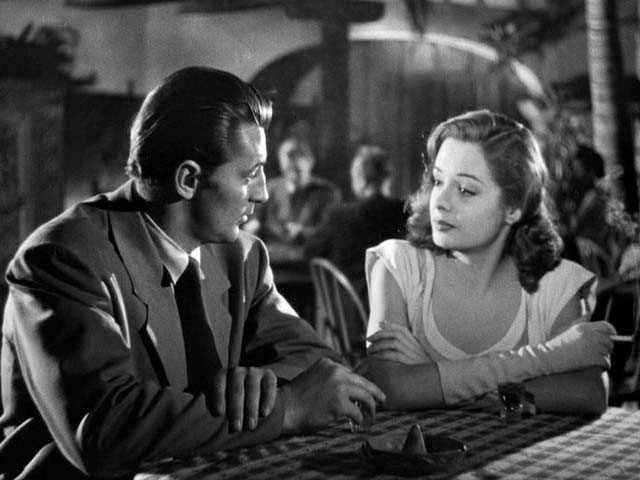8. Sorry, Wrong Number (1948)
Because it came shortly after the classic period of radio, many early film noir were based on radio dramas from the 1930’s and early 40’s, and Sorry, Wrong Number is perhaps the best known. The radio play starred Agnes Moorehead as the bedridden Leona Stevenson, but in the film the role was taken by frequent noir actress Barbara Stanwyck. Leona has overheard a phone call in which a woman’s murder is plotted for 11:15 that night; as she makes a series of calls, she gradually pieces the story together (through flashbacks, in the best noir tradition) that leads her to believe that he her husband, Henry, has set her up for the murder and that she is the woman who was being discussed in the call she overheard.
The film gives the backstory of Henry and Leona’s life. She is the daughter of wealthy owner of a chain of drugstores J.B. Cotterell (Ed Begley, Sr.), and Leona marries the poor Henry despite her father’s objections. Leona and her father keep Henry employed at Cotterell’s, but give him a meaningless job, and Henry eventually becomes involved in a scheme to steal drugs from Cotterells via a chemist named Wally Evans and sell them to the crooked Morano (frequent noir heavy William Conrad). Henry eventually gets in debt to Morano and has to sell out his wife – who has become bedridden due to her psychosomatic belief that she has a heart condition – to the crooks.
Stanwyck ratchets up the tension of the film as her performance becomes increasingly shrill and manic, as she gradually realizes that she is the target of the murder threat. The concluding scene is a masterpiece of noir drama. Sorry Wrong Number was made at Paramount, one of Hollywood’s most European influenced studios and was directed by Ukrainian Anatole Litvak with music by Franz Waxman, a frequent contributor to film noir.
7. The Big Sleep (1946)
Humphrey Bogart was the biggest star in Hollywood of the 1940’s and was featured in some of the best and well known film noir, including this film. Bogart is Phillip Marlowe, private detective character of hard boiled writer Raymond Chandler, and here he is paired with Lauren Bacall. The Bogart-Bacall off screen romance was well known and shortly after they appeared together in To Have and Have Not in 1944, Bogart divorced his wife and married Bacall.
On screen, the two generated such great chemistry in To Have and Have Not that Bacall’s part in the Big Sleep was expanded and re-written to give her more scenes with Bogey. Marlowe is summoned to the home of General Sternwood and asked to resolve a situation in which his young daughter Carmen (Martha Vickers) has come to owe bookseller Geiger $15,000 in gambling debts; Sternwood’s older daughter, Vivian Rutledge (Bacall) tells Marlowe that her father actually wants him to find her father’s young friend, Sean Regan, who has recently disappeared. Marlowe follows Geiger from his bookstore to his home where he hears a shot and on breaking in finds Geiger dead and the partially nude Carmen drugged and incoherent.
A hidden camera has been taking pictures of Carmen and the next day Vivian comes to Marlowe with the pictures, saying she is now being blackmailed. Marlowe finds that the Sternwood daughters are also involved with casino owner Eddie Mars, and Marlowe learns that Sean Regan may have run off with Mars’ wife. The complex plot is eventually resolved and the hard boiled detective, Marlowe, comes out in the clear.
The Big Sleep was a huge success and cemented the Bogart-Bacall partnership, on screen and off. Directed by veteran filmmaker Howard Hawks, The Big Sleep is the best known of the screen versions of Chandler’s Phillip Marlowe books, which also included Farewell, My Lovely, The Lady in the Lake and the Long Goodbye. It was remade in 1978 with Robert Mitchum as Marlowe.
6. The Postman Always Rings Twice (1946)
MGM was a glamour studio and did not make many film noir, instead concentrating more on romance films and musicals, but they produced one of the best in 1946 with the Lana Turner-John Garfield vehicle The Postman Always Rings Twice. Garfield is Frank Chambers, a drifter who shows up at the roadside diner owned by Cora Smith (Turner) and her much older husband Nick (Cecil Kellaway).
There is instant sexual tension between Cora and Frank, but Nick does not seem aware of it and hires Frank on to help around the diner. Soon Frank is helping himself to Cora and the two plan to get rid of Nick and grab the diner for themselves via the usual noir way: murder. Their first attempt fails, but the second attempt succeeds when they bludgeon the inebriated Nick and send him over a cliff in his car. D.A. Kyle Sackett (Leon Ames) suspects the couple in the murder and eventually tries to get them to turn on each other.
Neither Frank nor Cora fully trust the other, and Sackett tries a clever ploy to get the truth out of Cora but Cora’s clever lawyer, Arthur Keats, ends up getting his client off with a manslaughter charge and probation. Cora and Frank return to the diner where they eventually end up marrying, but they don’t trust each other and the relationship is uneasy. Finally, just as it appears Frank and Cora will find happiness, it is snatched away from them by cruel fate.
The Postman Always Rings Twice was reminiscent of Double Indemnity in the sense that a situation of high sexual tension leads to murder. The resulting distrust and suspicion put the characters under a cloud that they cannot escape from, and eventually their fate is sealed and their relationship doomed. In the world of film noir, sexual tension almost always leads to a bad end, and nowhere is that more evident than in The Postman Always Rings Twice. The film was remade in 1981 with Jack Nicholson and Jessica Lange, but was a critical and commercial failure.
5. Detour (1945)
The other films on this list were all made at big studios with “A” stars, but Detour is unusual as it was a low budget film featuring the relatively unknown Tom Neal as Al Roberts and Ann Savage as Vera. The film was directed by Austrian Edgar Ulmer, another veteran of the German film industry of the 1920’s, and was shot on a quick schedule and low budget.
The film begins with Al Roberts telling his story in flashback at a roadside diner. Roberts is a jazz musician living in New York who has a falling out with his girlfriend. When she leaves to go to Hollywood to seek fame and fortune, Roberts goes after her but having little money has to hitch-hike. He is picked up by pill popping Charles Haskell who dies during a night of driving; nervous Al decides instead of telling the police and risking being accused of murder, he is better off taking Haskell’s car, money and identity. His mistake comes when he picks up a hitch-hiker, the oily Vera, who earlier had been given a ride by Haskell and fought off his advances. Knowing that Al is not Haskell,
Vera blackmails him and the two enter into a bitter relationship of distrust and hatred. The situation turns grave for Al when they arrive in L.A. and Vera learns that Haskell’s wealthy father is on his death bed and decides that Al should continue impersonating Haskell so they can collect the inheritance. Having made the fateful detour by picking up Vera and becoming ensnared in her web, Al bemoans his situation saying “Fate, or some mysterious force, can put the finger on you or me for no good reason at all.”
This may be the ultimate statement of film noir, and this gritty film whose reputation rose radically in the 1970’s and 80’s, is one of the best representations of the nightmare noir world in which an otherwise innocent man becomes enmeshed in a serious of circumstances from which he cannot disentangle himself. Film noir did not necessarily require big stars and could be made for little money and on a tight schedule, and nowhere is that more evident than in Detour, which has finally achieved the successful reputation it deserves.
4. The Maltese Falcon (1941)
Generally considered the film that started the genre (or cycle, if you prefer), The Maltese Falcon introduced Humphrey Bogart as a hard boiled leading man and also was the first film directed by John Huston, who would direct several later noir films.
Bogart is Dashiell Hammet’s Sam Spade, whose San Francisco detective agency Spade & Archer is visited by a Miss Wanderly, who turns out to be Brigid O’Shaughnessy (Mary Astor). She requests the detectives find a man named Floyd Thursby whom she says has run off with her younger sister but when Archer goes to tail Thursby he is shot dead. Thursby is also killed later that same night, and Spade is pulled into a whirlwind of mystery and drama as the police suspect him of killing Archer, as Spade had earlier had an affair with his partner’s wife.
Trying to get the truth out of Brigid is difficult, and eventually Joel Cairo (Peter Lorre) convinces Spade to help him find the priceless ‘Maltese Falcon’, which is being sought also by Kasper Gutman (Sidney Greenstreet) and his hired gun Wilmer (Elisha Cook, Jr.). The Falcon is supposedly coming in on a ship and when the ship’s captain arrives with the Falcon at Spade’s office he is dying of a gunshot wound. In a final showdown, Spade must sort out whom to turn over to the police for the various murders and also, of course, who gets the Falcon.
As in many of Huston’s other films, particularly The Treasure of the Sierra Madre (1948), the film is all about a group of rogues seeking ill gotten gain, which none of them end up obtaining. Bogart was superb as Spade and he gets all the film’s good lines, including the classic finale when asked by the police what the Maltese Falcon statue is, he can only reply: “The, uh, stuff that dreams are made of!” Produced at Warner Brothers, The Maltese Falcon was the first of many hard boiled detective films that dominated the box office in the 1940’s and was the beginning of a great run for Bogart as Hollywood’s top male star.
3. Double Indemnity (1944)
While The Maltese Falcon is considered the first and most groundbreaking film noir, Billy Wilder’s Double Indemnity, made three years later, established most of the conventions of the early ‘classic’ period. The ostensible ‘hero’ of the film is not an honorable man like Sam Spade; instead, it is Walter Neff (Fred MacMurray), an easy going life insurance salesman who falls into the spider’s web set by Phyllis Dietrichson (Barbara Stanwyck) when he comes to talk to her about the renewal of her husband’s life insurance policy.
Phyllis convinces Walter to help her kill her unlikeable husband, then make it appear as if the man has fallen from the back of a train so that the grieving widow can get double indemnity on his life insurance policy because the death was by accident. Barton Keyes (Edward G. Robinson), Neff’s friend and insurance investigator immediately suspects foul play, but he doesn’t know that his friend and associate is a co-conspirator in the crime.
The story in Double Indemnity is told by Walter Neff in flashback, and this technique became a standard practice in most of the film noir to come over the next five years. The sense of doom, coincidence, entrapment and distrust that pervade Double Indemnity all quickly also became conventions of film noir. Based on a novel by hard boiled writer James M. Cain, Wilder broke away from his normal writing partner Charles Brackett to pen the screenplay for Double Indemnity with another hard boiled writer, Raymond Chandler.
The film was a huge hit, winning best picture Oscar and won Wilder has first best directing statue and also Stanwyck for best actress. The score was by Miklos Rozsa, another European emigre who did the music for many film noir. Viewed today, Double Indemnity might seem a little corny, but that is only because the numerous conventions that it established have been so often used and overused in the years since; at the time of its release, the film was a groundbreaker.
2. The Killers (1946)
Released just after the end of World War II, the Killers has all the elements that made film noir what it was in its early incarnation. The first twenty minutes of the film are based directly on the Ernest Hemingway short story of the same name, taken from the series of Nick Adams stories that Hemingway wrote. Two hit men arrive in a small town demanding to know the whereabouts of Ole Andreson (Burt Lancaster, in his first film role), known as “the Swede”. Nick Adams goes to warn the Swede that the killers are coming, but the Swede is resigned to his fate, saying “I got in wrong once” and he is executed by the killers in his bed.
Andreson’s death is investigated by life insurance investigator Jim Reardon (Edmund O’Brien) and as Reardon interviews the Swede’s friends his story is told in flashback. A boxer who had to retire from the ring due to an injury, the Swede falls in with a bad crowd including the beautiful Kitty Collins (Ava Garnder) and ‘Big Jim’ Colfax (Albert Dekker) and ends up taking a rap for Kitty and going to prison for three years. When he gets out, he again becomes involved with Kitty and Big Jim, who is planning payroll robbery.
Kitty warns the Swede that Big Jim is planning to double cross him and, after the heist, she and the Swede make off with the money and go to Atlantic City, but Kitty eventually disappears with the loot. Reardon ends up figuring it all out and solves the crime at a final showdown at Big Jim’s mansion. Although the Swede and Reardon never appear together in the film at the same time, the investigator seems to identify with the troubled ex-boxer and takes on the solving of his case as a personal matter.
Directed by German emigre Robert Siodmak, who also directed a number of other film noir after this, The Killers established Lancaster as a talent to be reckoned with, and put Ava Gardner on the map as the ultimate duplicitous femme fatale, Kitty Collins. In the world of film noir, beautiful woman cannon be trusted, and a man who gives into to their charms quickly finds himself ensnared in a web of crime and deceit from which he cannot easily escape; even when he tries to run and hide, the past eventually catches up with him and so it is no surprise that the Swede gives in to his fate with a saddened resignation.
1. Out of the Past (1947)
Taking up a similar theme as The Killers is the number one greatest film noir of the early period, Out of the Past, made at RKO in 1947 and directed by Jacques Tourneur. Jeff Markham (Robert Mitchum) is, like the Swede, running from his past and living in a small California town as the proprietor of a gas station. When thug Joe Stefanos comes through the town he recognizes Markham and tells him that Whit Sterling (Kirk Douglas, in his second film role) wants to see him.
Jeff drives to Lake Tahoe to see Whit with his small town girlfriend, the pretty blonde Ann Miller, and tells her the story of his past in a flashback. He and his detective partner, Fisher, were hired by Whit to find Kathie Moffatt (Jane Greer) who has run off with $40,000 of Whit’s money. Jeff goes to Acapulco to find the beautiful Kathie, but when he does she convinces him that she did not steal the money and Jeff falls in love with her; they evade Whit and Stefanos and head to San Francisco to begin a life together, only to eventually be confronted by Jeff’s old partner, Fisher, who wants to blackmail them. Kathie ends up shooting Fisher and runs away, leaving Jeff to clean up the crime.
Now back in the present, Jeff parts reluctantly with his girlfriend and meets with Whit, finding Kathie having returned also. Whit forces Jeff to go on another job for him to San Francisco to shake down Leonard Eels, an attorney who has some papers that can implicate Whit in a tax fraud scheme. Jeff tells his cabbie friend “I think I’m in a frame” as he goes to the apartment of Meta Carson (Rhonda Fleming), Eel’s secretary. Eventually Jeff ends up back in Tahoe in a showdown with Whit and Kathie, having to make some ultimate choices between the blonde good girl (Ann) and the dark haired, sexy but deceitful femme fatale (Kathie).
In true noir tradition, he makes the right choices, telling Kathie “Then you can build my gallows high…” but the results end up all wrong. Mitchum is the ultimate noir hero, his tough guy persona and heavy eye lids drawn into a web of intrigue and dirty double crossing that he cannot escape from, even when he tries to hide in a small town. With its emphasis on fate and the impossibility of outrunning the past, with its oily bad guy, beautiful, dangerous femme fatale and fated, hard boiled protagonist, Out of the Past is the complete and ultimate film noir.
Author Bio: Jim Davidson is a 1980 graduate of Northwestern University’s Radio-TV-Film Dept. He lives in the San Francisco Bay Area and has been a video producer since 1987. Jim has written articles for Images Film journal and is currently working on a book about the movie Harold and Maude.
